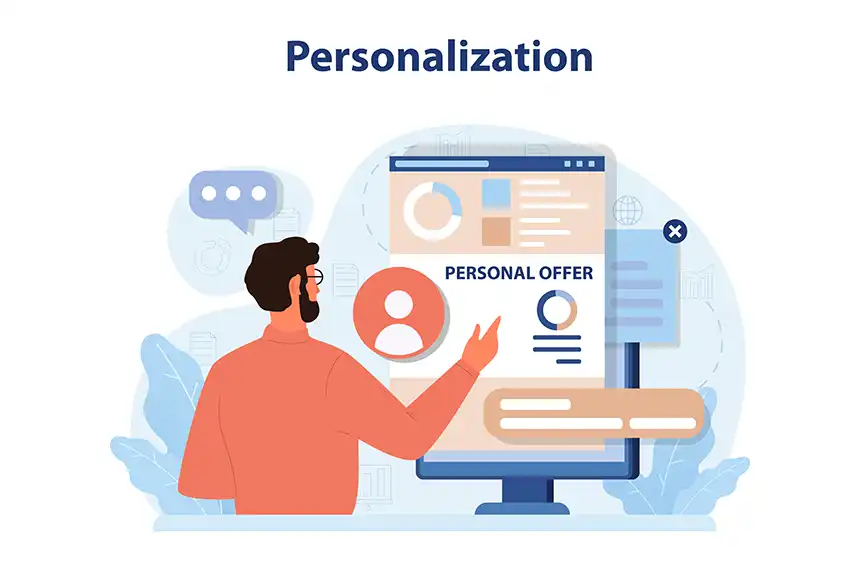eCommerce Personalization: Strategies for Success

Amanda Jones

It’s the fourth time you’ve visited a website. Two previous times, you made a purchase, and now you’re looking for some items to complement what you bought.
Why are you back again? Not only did you receive two follow-up emails after you made your last purchase, but when you reached the website, there was a curated list of complimentary items waiting for you to browse.
Achieving that level of personalization requires brands to be dialed in with their content authoring and delivery processes. Creating a personalized experience is critical for any commerce initiative; that is where a headless CMS and composable architecture comes into play.
In this blog, we’ll explain the ins and outs of ecommerce personalization and provide some strategies for achieving success.
What Is eCommerce Personalization? (And Why It Matters)
eCommerce personalization is the practice of creating a curated and personalized experience for individual customers. This includes providing different offers and dynamic pricing based on previous on-site behavior, demographics, and preferences.
However, the full effects of eCommerce personalization occur when companies deliver relevant content to customers through product recommendations, blog articles, ad retargeting, and push notifications.
For example, if a customer regularly visits a home goods store to purchase kitchen gadgets, the website tracks their on-site behavior and purchase history. Each time they revisit the site, the latest kitchen appliances are shown to them. On the other hand, another customer who regularly purchases office electronics and similar gadgets sees those items in the monthly newsletter in their inbox.
Ultimately, eCommerce personalization helps to improve the customer experience and increase customer satisfaction and conversions with a personalized shopping experience when the customer interacts with a brand.
Why eCommerce Personalization Matters
As eCommerce continues to experience unprecedented growth, so too has the competition intensified. While retail eCommerce sales amounted to $1.5 trillion in 2015, they amounted to $5.7 trillion in 2022. Personalization provides a unique selling proposition and a competitive edge, helping companies stand out in crowded markets.
Additionally, companies today have access to vast amounts of data. However, with the phasing of third-party cookies and the growing importance of first-party and zero-party data, leveraging this data for eCommerce personalization allows businesses to make informed decisions. Hence, 67.2% of customers are somewhat comfortable with providing data to companies in exchange for a better experience.
Most importantly, modern consumers have become accustomed to personalized experiences across various touchpoints. Companies that fail to meet these expectations risk losing customers to competitors who offer more tailored and relevant interactions.
Benefits of eCommerce Personalization
Personalization can be the ultimate difference maker for eCommerce businesses, offering several benefits.
More Sales Conversions
eCommerce personalization increases the likelihood of users finding and consequently purchasing the exact products they’re looking for. Instead of browsing multiple pages on a site they’ve frequented, they are greeted by the precise products they want when they’re ready to buy.
Improved Customer Engagement
Customer engagement increases with a personalized shopping experience. Personalized content, recommendations, and promotions capture user attention as customers often deem them relevant to their interests and preferences. This leads to them browsing longer and returning more frequently due to an enjoyable experience.
Increased Customer Loyalty
Personalization can build a sense of loyalty and connection with customers. The feeling of being understood and catered to enhances customer satisfaction, encouraging repeat business and long-term loyalty.
Deeper Understanding of Customers
Brands need to leverage customer data to provide a personalized experience. Access to this data and experimenting with different personalized content types can provide a deeper understanding of customers. The more a company understands its customers, the better it can tailor its content and overall marketing approach to meet customer expectations.
Competitive Advantage
Personalization helps businesses match their customers’ search and buying intent, which can help them distinguish them from the competition. The better the personalized experience, the better the ability to attract and retain customers, creating a unique selling proposition that sets them apart in the marketplace.
Better Customer Experience
The overall benefit of eCommerce personalization is a better customer experience. The shopping journey becomes smoother and more enjoyable through customized recommendations and personalized communication.
Strategies to Achieve eCommerce Personalization For Your Business
The days of simply personalizing an email with a customer’s name and expecting the best results are long gone. This basic level of personalization is still a requirement, but achieving success with eCommerce personalization requires businesses to leverage content and the right technologies.
- Research audience and segment customers: Personalization starts with knowing what you want to personalize. This requires you to research your audience so that you can be sure about which data to collect and how customers will need to be segmented once that data is collected.
- Personalize the right elements: The next step should be to identify the key elements that will significantly impact the customer experience, i.e., the elements of an eCommerce website that should be personalized. This could include personalized product recommendations, localized content relevant to a customer’s location, targeted discounts based on purchase history, and incorporating user-generated content to build trust and authenticity.
- Automate personalized messages: Brands today are finding new ways to leverage the capabilities of AI and machine learning algorithms and incorporate different MarTech systems, such as marketing automation tools and personalization engines. Using automation allows you to deliver timely and personalized messages to your customers. This could include automated emails, push notifications, or in-app messages triggered by specific customer actions or events.
- Deliver dynamic content: Dynamic content, which refers to content on a website or app that changes based on user behavior, preferences, demographics or other known attributes, ensures that each potential customer sees content most relevant to them at any given moment, creating a more engaging and personalized experience. For eCommerce websites, homepages and category or product pages are the most common areas for introducing this type of content. For example, brands can showcase trending products, personalized recommendations, or dynamic banners that change based on user segments.
- Use a headless CMS: Given the importance that content plays in providing a personalized eCommerce experience, a headless CMS can provide the features to build tailored, engaging experiences. By separating the frontend of the CMS from the backend, businesses can deliver content to any frontend interface, whether a website, mobile app, or digital kiosk. With a headless CMS, businesses will find it easier to engage in omnichannel personalization, content commerce, and build the integrations that support eCommerce personalization.
- Leverage a composable architecture: Pairing a headless CMS with a composable architectural approach enables businesses to build a composable tech stack where they choose the best tools and technologies to achieve eCommerce personalization goals. This usually includes a headless CMS to manage content and also leverages a backend eCommerce platform (for product detail, pricing, checkout, etc.), search, and A/B test and experimentation tools.
Personalizing eCommerce Experiences with CrafterCMS
Personalizing eCommerce experiences requires businesses to manage the content aspect of the shopping experience. While an eCommerce platform is ideal for managing sales, inventory, and other elements, a modern headless CMS, like CrafterCMS, is essential for delivering a personalized experience.
Read More: Using a Headless CMS to Personalize eCommerce
CrafterCMS is an enterprise-grade, headless and composable CMS with numerous features that allow eCommerce brands to personalize the customer shopping experience across multiple channels.
- Crafter Studio: A best-in-class content creation and authoring application that enables marketing teams to use drag-and-drop functionality and in-context preview to create digital experiences across any channel.
- Crafter Engine: Content delivery services that power any type of web or mobile application. Crafter Engine delivers content published through Crafter Studio via robust, comprehensive and extensible APIs, giving developers the foundation to create high-performance and flexible shopping experiences.
- Content Targeting: With CrafterCMS, it’s possible to define personas and segment users within the target audience, providing them with tailored content experiences. Content items can be tagged and metadata added to help drive personalized behaviors.
- Localization: Crafter Studio enables businesses to connect to third-party language translation services and offer a localized experience for customers shopping in different regions and countries.
- DevContentOps: Using DevContentOps processes, CrafterCMS enables businesses to eliminate content silos and remove bottlenecks that can limit how they create, test, and optimize personalized experiences, improving efficiency between software developers, content teams, and IT operations.
Learn more about how to deliver personalized eCommerce experiences with the help of a headless CMS by watching our video: CrafterCMS Audience Targeting.
Related Tags
Related Posts

Websites Are Dead?

Mike Vertal

No-Code Experience Building for Marketers & Designers

Amanda Lee

The Future of Web Experiences: From Browsing and Searching to Conversational AI

Mike Vertal

Is Your CMS MACH-Ready? A Practical Guide for Enterprise Architects

Sara Williams
Related Resources
-

CrafterCMS at eBay: The Universal Content Platform for eBay.com
Webcast
-

Personalized Digital Experiences for a Cruise Liner
Webcast
-

Introducing CrafterCMS v4.0
Webcast
-

Modernizing Video Delivery and Content Management at CPAC, A Canadian Nationwide Broadcaster
Webcast
-

Building React Apps on a Headless CMS
White Paper





